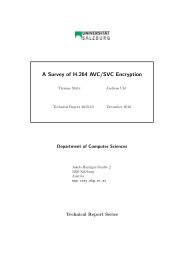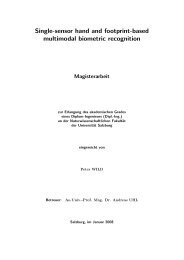Pit Pattern Classification in Colonoscopy using Wavelets - WaveLab
Pit Pattern Classification in Colonoscopy using Wavelets - WaveLab
Pit Pattern Classification in Colonoscopy using Wavelets - WaveLab
You also want an ePaper? Increase the reach of your titles
YUMPU automatically turns print PDFs into web optimized ePapers that Google loves.
5 Results<br />
(a) 2 classes<br />
(b) 6 classes<br />
Figure 5.13: Distance matrices for the two classes and the six classes case (<strong>Pit</strong> pattern images)<br />
Class 1 2 3 4 5 6<br />
1 96 4 0 0 0 0<br />
2 7 93 0 0 0 0<br />
3 0 0 77 9 9 4<br />
4 0 0 10 64 14 12<br />
5 0 0 4 19 52 24<br />
6 0 0 0 8 27 64<br />
Table 5.18: Result distribution matrix for CC for 6 classes (Outex images)<br />
result distribution matrix for the six classes case is quite different compared to the result<br />
distribution matrices for the previous methods, as we notice from table 5.18. We can see<br />
that while the first two classes get classified fairly well, the classification rate is gett<strong>in</strong>g<br />
lower for the classes 3 to 6, with the lowest classification result of 52% only for class 4.<br />
Figure 5.14 shows the distance matrices for the two classes and the six classes case. In<br />
contrast to the distance matrices presented above for the pit pattern images, these matrices<br />
are similar to the example distance matrices presented <strong>in</strong> figure 4.5. Especially for the distance<br />
matrix for the two classes case shown <strong>in</strong> figure 5.14(a) we are able to clearly identify<br />
a typical structure for low <strong>in</strong>tra-class distances and high <strong>in</strong>ter-class distances.<br />
88








